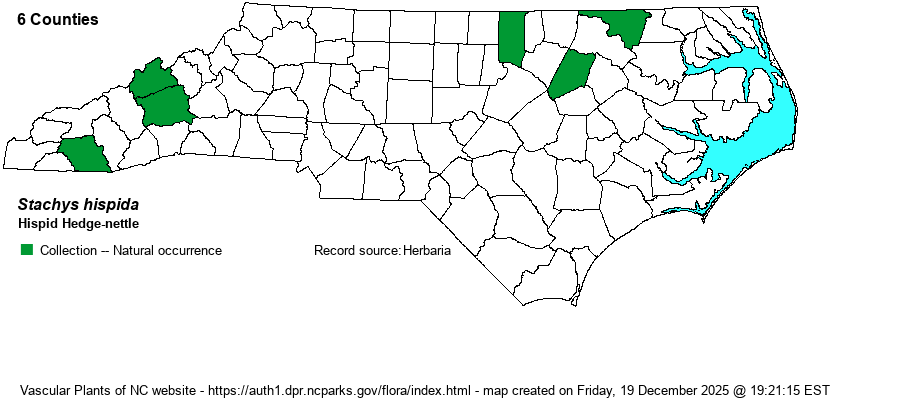| Author | Pursh | |
| Distribution | Very uncertain and confusing, as well as confused, certainly under-collected and certainly also misidentified by biologists. As some references state, this is a problematic species, almost grading into S. tenuifolia in some ways and into other species as well. The journal paper by Fleming et al. (2011) may be most helpful in understanding S. hispida. Weakley (2024) also says "A highly variable taxon", and "Mapping is highly speculative". For now, it is known from collections in the northwestern Coastal Plain and adjacent northeastern Piedmont; plus a few counties in the central and southern Mountains.
Weakley (2020) gives its range as "ME west to MB and ND, south to MD, GA, and AR."
| |
| Abundance | Poorly known, but based on known records and Weakley's map, the editors suggest a rank of [S2?] for now. The NCNHP and NatureServe do not even list this species at all. Because of such uncertainty, at a minimum the website editors suggest that it should be added to the Watch List, as W7 (rare but poorly known). | |
| Habitat | This is mainly a wetland species, found in damp meadows, openings and edges of wetland forests, and along stream margins. It is considered weedy in parts of its range, and it favors sunny to partly sunny places. The very similar S. tenuifolia grows in shadier places and in richer soils, mostly in rich sediments of brownwater rivers. | |
| Phenology | Blooms from June to August, and fruits from September to October. | |
| Identification | This is a rather standard Stachys, with the stems "moderately to densely pubescent on the angles with hairs to 3 mm", as opposed to "stem glabrous to moderately pubescent on the angles" (Weakley 2018) in S. tenuifolia, with which these should probably be considered as varieties. The paired leaves of S. hispida have "petioles rarely as much as 1-2 cm long", as opposed to "petioles well developed (1-3 cm long), especially in shade forms". This species has "leaves usually pubescent above (some forms glabrate)" as opposed to "leaves sparsely pubescent or glabrate" in S. tenuifolia. Lastly, S. hispida has "Calyx hispiduous to strongly hispid with long, stiff, deflexed hairs", as opposed to "Calyx glabrous to moderately pubescent with short, soft hairs" in S. tenuifolia. In general, S. hispida has a visual look of a species with a relatively short petiole and rather hairy/hispid stems and leaves (and calyx lobes), whereas S. tenuifolia -- which often grows in the same general range -- is a "smooth" species with a noticeably long petiole of about 1-inch long. Much is still to be learned about the identity of Coastal Plain and Piedmont members of the genus! See also the comments and key to Southeastern taxa in Fleming et al. (2011). | |
| Taxonomic Comments | See above. Note that some older references, such as Gleason (1952), do list this species, but this old references included S. tenuifolia within it. Considering that NatureServe does not list it, nor as a variety, this is quite telling that these two entities might best be considered as varieties of a common species.
Stachys is a large and complex genus that is still actively being worked on, and our understanding of the species is slowly being clarified. For interested readers, we recommend journal papers by Nelson (1981, 2008) and by Fleming et al. (2011). | |
| Other Common Name(s) | Hairy Hedge-nettle | |
| State Rank | [S2?] | |
| Global Rank | GNR | |
| State Status | [W7] | |
| US Status | | |
| USACE-agcp | | |
| USACE-emp | | |

